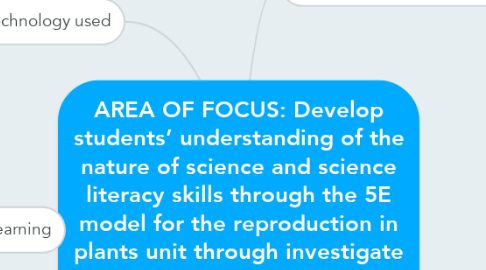
1. Students' Learning Outcomes
1.1. 21st CC
1.1.1. Self-directed learner
1.1.2. Critical and Inventive Thinking
1.1.3. Communication, Collaboration and Information Skills
1.2. Key Science Concepts to be learnt
1.2.1. 1. Recognise processes in the sexual reproduction of flowering plants. - pollination - fertilisation (seed production) - seed dispersal - germination
1.2.2. 2. Recognise the similarity in terms of fertilisation in the sexual reproduction of flowering plants and humans.
1.2.3. 3. Investigate the various ways in which plants reproduce and communicate findings. - spores - seeds
1.2.4. 4. Show curiosity in exploring the surrounding plants and animals by asking questions. Show concern by being responsible towards plants and animals such as their own pets Value individual effort and team work by respecting different perspectives.
1.2.5. 5. Show concern by being responsible towards plants and animals such as their own pets.
1.2.6. 6. Value individual effort and team work by respecting different perspectives.
1.3. Alternative Concepts to be addressed
1.3.1. Students are unable to identify that structures that enable seed dispersal are methods of adaptation for reproduction
1.3.2. Students are unable to view that fruits form from flowers.
1.4. Prior Knowledge of Pupils
1.4.1. Students are aware of the life cycle and parts of a plant.
2. Evidence of Student Learning
2.1. Formative assessment
2.1.1. Responses on Edmodo
2.1.2. Feedback provided to peers
2.1.3. Online quizzes
3. Technology used
3.1. edmodo
3.1.1. For collaboration and communication
3.1.2. Make learning mobile
3.2. Edpuzzle
3.2.1. Flipped learning to encourage students to be self-directed learners
3.3. Digital Products
3.3.1. Use of digital photographs
3.4. Google
3.4.1. For evaluation and collaboration

